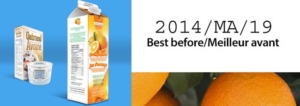Understanding Shelf Life, Best Before, and Expiry Dates in Canada
As Canadian citizens, we encounter food products on a daily basis, each stamped with different dates: shelf life, best before, and expiry dates. These dates play a role in ensuring food safety and quality. Lets discuss what they mean, and their importance:
#1 – Shelf Life
Shelf life refers to the period that a product remains safe to consume and maintains its intended quality when stored under proper conditions. It’s important to note that shelf life is an estimate and can vary depending on storage temperature, humidity, and packaging. In Canada, manufacturers determine shelf life through rigorous testing to ensure their products are safe and meet quality standards.
Example: Canned goods such as our pasta line, or rice, sealed they have a shelf life of 20-30 years. If stored correctly in a cool, dry place, they remain safe to eat for an extended period. Opened/unsealed they have a shortened shelf life of anywhere from 6-18months.
#2 – Best Before Date
The best before date is a label indicating the date until which a product will maintain its optimal quality, taste, and texture, as determined by the manufacturer. After this date, the product may still be safe to eat, but its quality might deteriorate. In Canada, the “best before” date is a legal requirement for most packaged foods.
Example: A box of cereal might have a “best before” date of September 30, 2023. While likely fine to eat after this date, the manufacturer cannot guarantee it will taste as fresh or crunchy as intended.
#3 – Expiry Date
An expiry date is the date by which a product must be consumed for safety reasons. After this date, the product is no longer be safe to eat, regardless of its appearance, taste, or smell. Expiry dates are typically found on perishable items like dairy products and certain medications, where the risk of spoilage is significant.
Example: A carton of milk will usually have an expiry date, and it’s important to discard it after this date has passed, as consuming expired dairy products can lead to health risks.

Here is a 16 minute podcast about food labels created by the CFIA (Canadian Food Inspection Agency) for added information.
Other Key Words & Phrases
In understanding shelf life, best before dates, and expiry dates in Canada, it is helpful to be aware of additional phrases and words that provide valuable information about the product’s quality and safety. Here are some key terms and phrases to look for:
- Packaging Date or Manufacture Date: This date indicates when the product was packaged or manufactured. It can determine a product’s freshness, especially when it does not have a best before date listed.
- Lot Number or Batch Code: Lot numbers or batch codes are unique identifiers used by manufacturers to track products. They are used for tracing and identifying specific products in case of recalls or quality issues.
- Frozen By Date: For frozen foods, this date indicates when the product was frozen. It can help you gauge how long the item has been in storage.
- Refrigerate After Opening or Keep Refrigerated
- Open and Close Arrows: These arrows or symbols on packaging indicate how to properly open and reseal a product to maintain its freshness.
- Allergen Declarations: Look for statements indicating the presence of common allergens such as peanuts, tree nuts, dairy, soy, wheat, and shellfish.
- No Preservatives Added: This may affect the product’s longevity.
- Organic: This may influence its shelf life.
Conclusion:
Understanding the differences between shelf life, best before, and expiry dates is important for maintaining food safety and quality in your homes. We should check these labels when shopping for groceries and be mindful of them when storing and consuming food products. By doing so, we can ensure that the food we eat is both enjoyable and safe. Happy eating!




